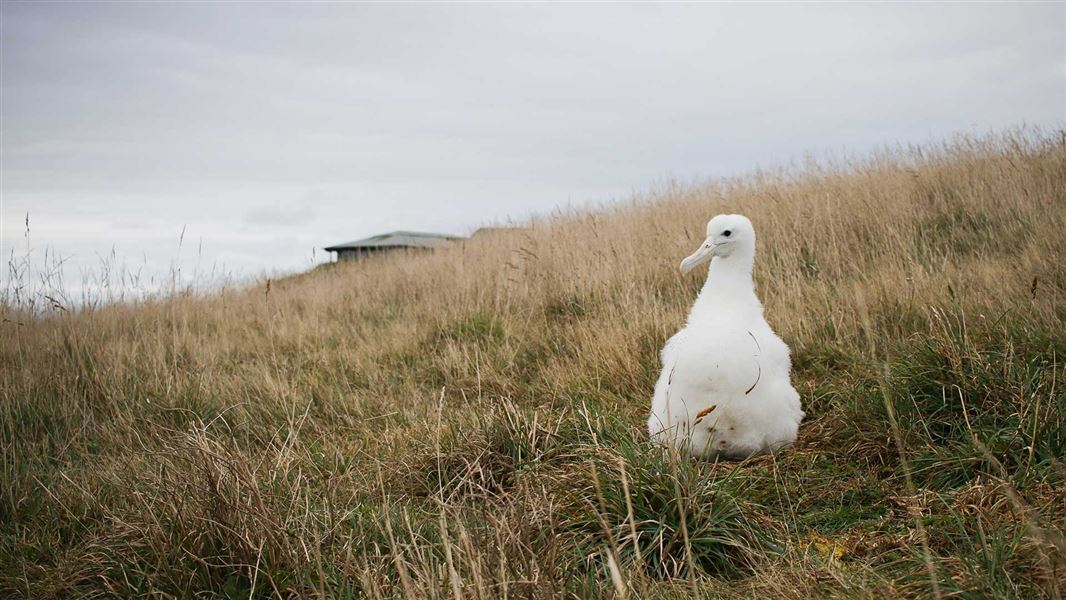Archived content: This media release was accurate on the date of publication.
Date: 15 July 2021
Last week, a 146-day-old male chick died after a routine supplementary feeding was carried out.
The rangers noticed the chick had laboured breathing after the feed. The bird’s condition deteriorated very quickly and unfortunately it died. The chick was underweight for its age and needed extra food to help it gain weight.
The chick was sent to Massey University for a necropsy to determine the exact cause of death.
Department of Conservation (DOC) Supervisor Jim Watts says the necropsy found a sizeable piece of rocky material (resembling charcoal) stuck in chick’s trachea, which led to the chick asphyxiating.
It is not known how the chick first ingested the rock, but it is thought the parent may have picked it up while fishing (as charcoal floats) and fed it to the chick, which then regurgitated the material while being supplementarily fed and inhaled it.
“Our rangers out at Taiaroa Head are dedicated to caring for these special birds, working long hours, over holiday periods and in tough conditions to give them the best chance of survival, so this incident is hard for the team.”
Jim Watts says supplementary feeding of toroa chicks is a routine activity that has been used successfully for decades at the Pukekura colony. For chicks that are very underweight, weighing and feeding occurs multiple times a week to ensure their weight is increasing.
Over the last three seasons, more than 275 supplementary feeds have been carried out and this is the only time there was an incident.
“Chicks can become underweight for several reasons. Their parents may be inexperienced foragers or new to feeding a chick, there may be poor food resources at sea, or the chick may have lost a parent so is only getting food from one parent. It may also be caused by an underlying health condition,” Jim Watts said.
“The colony at Pukekura is intensively managed to give the chicks the best chance of survival. Issues that rangers help to mitigate include extreme temperatures, fly strike on hatching chicks, predators, and underweight chicks.”
Jim Watts says intensively managing a species always carries some level of risk, but without the management and intervention at Pukekura many of the chicks would not successfully fledge each breeding season and join the colony when they return from sea in four to eight years’ time.
DOC will be reviewing what happened to see what can be learned, or if there are things that could be done differently to further reduce the risk of this happening again.
There are 32 chicks remaining at Pukekura/Taiaroa Head, which is still a record number since the first chick fledged from the headland in 1938.
Background information
Toroa/northern royal albatross are one of the largest seabirds in the world, with wingspans up to 3 m. They are a vulnerable species that has been affected by changes to habitat and climate and by some fishing practices.
They also reproduce slowly, with breeding pairs typically raising a chick once every two years.
A summary of the number of chicks fed and the number of total feeds given over the past three breeding season is shown below. All previous feeds were without incident.
| Season | Number of chicks hatched | Number of chicks fed by rangers | Total feeds |
|---|---|---|---|
| 2018/2019 | 34 | 14 | 152 |
| 2019/2020 | 28 | 16 | 49 |
| 2020/2021 | 36 | 15 | 77* |
| * This cohort has not yet fledged. | |||
The recent chick death is the fourth of the season. The other three all died in the weeks after hatching of natural causes.
DOC manages the albatross colony at Pukekura/Taiaroa Head with the support of the Otago Peninsula Trust, Te Poari a Pukekura (Pukekura Co-management Trust, which governs Pukekura/Taiaroa Head) and Dunedin City Council. The site is the only mainland albatross colony in the Southern Hemisphere and has grown from one breeding pair in 1937 to more than 65 pairs this season.
Pukekura/Taiaroa Head is a significant site for its cultural and historic values, and for the other taonga species that live there. It is home to about 10,000 birds including red-billed gulls, little penguins, spotted shags, Otago shags, tītī, and royal spoonbill.
Contact
For media enquiries contact:
Email: media@doc.govt.nz
